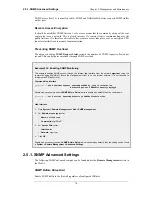
The following example adds an Ethernet Address object named wwwsrv1_mac with the numerical MAC address
08-a3-67-bc-2e-f2.
Command-Line Interface
gw-world:/> add Address EthernetAddress wwwsrv1_mac
Address=08-a3-67-bc-2e-f2
Web Interface
1.
Go to Objects > Address Book > Add > Ethernet Address
2.
Specify a suitable name for the Ethernet Address object, for example wwwsrv1_mac
3.
Enter 08-a3-67-bc-2e-f2 as the MAC Address
4.
Click OK
3.1.4. Address Groups
Groups Simplify Configuration
Address objects can be grouped in order to simplify configuration. Consider a number of public
servers that should be accessible from the Internet. The servers have IP addresses that are not in a
sequence, and can therefore not be referenced to as a single IP range. Consequently, individual IP
Address objects have to be created for each server.
Instead of having to cope with the burden of creating and maintaining separate filtering policies
allowing traffic to each server, an Address Group named, for example web-servers, could be created
with the web server hosts as group members. Now, a single policy can be used with this group,
thereby greatly reducing the administrative workload.
IP Addresses Can Be Excluded
When groups are created with the Web Interface, it is possible to not only add address objects to a
group but also to explicitly exclude addresses from the group. However, exclusion is not possible
when creating groups with the CLI.
For example, if a network object is the network 192.168.2.0/24 and this is added to a group, it is
possible to then explicitly exclude the IP address 192.168.2.1. This means that the group will then
contain the range 192.168.2.2 to 192.168.2.255.
Groups Can Contain Different Subtypes
Address Group objects are not restricted to contain members of the same subtype. IP host objects
can be teamed up with IP ranges, IP networks and so on. All addresses of all group members are
then combined by NetDefendOS, effectively resulting in the union of all the addresses.
For example, if a group contains the following two IP address ranges:
•
192.168.0.10 - 192.168.0.15
•
192.168.0.14 - 192.168.0.19
The result of combining these two will be a single address range containing 192.168.0.10 -
192.168.0.19.
3.1.4. Address Groups
Chapter 3. Fundamentals
83
Summary of Contents for DFL-1600 - Security Appliance
Page 27: ...1 3 NetDefendOS State Engine Packet Flow Chapter 1 NetDefendOS Overview 27 ...
Page 79: ...2 7 3 Restore to Factory Defaults Chapter 2 Management and Maintenance 79 ...
Page 146: ...3 9 DNS Chapter 3 Fundamentals 146 ...
Page 227: ...4 7 5 Advanced Settings for Transparent Mode Chapter 4 Routing 227 ...
Page 241: ...5 4 IP Pools Chapter 5 DHCP Services 241 ...
Page 339: ...6 7 Blacklisting Hosts and Networks Chapter 6 Security Mechanisms 339 ...
Page 360: ...7 4 7 SAT and FwdFast Rules Chapter 7 Address Translation 360 ...
Page 382: ...8 3 Customizing HTML Pages Chapter 8 User Authentication 382 ...
Page 386: ... The TLS ALG 9 1 5 The TLS Alternative for VPN Chapter 9 VPN 386 ...
Page 439: ...Figure 9 3 PPTP Client Usage 9 5 4 PPTP L2TP Clients Chapter 9 VPN 439 ...
Page 450: ...9 7 6 Specific Symptoms Chapter 9 VPN 450 ...
Page 488: ...10 4 6 Setting Up SLB_SAT Rules Chapter 10 Traffic Management 488 ...
Page 503: ...11 6 HA Advanced Settings Chapter 11 High Availability 503 ...
Page 510: ...12 3 5 Limitations Chapter 12 ZoneDefense 510 ...
Page 533: ...13 9 Miscellaneous Settings Chapter 13 Advanced Settings 533 ...











































